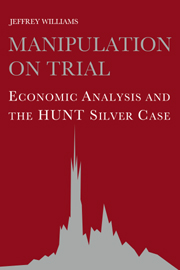Book contents
- Frontmatter
- Contents
- List of figures
- List of tables
- Preface
- Foreword by Thomas O. Gorman
- 1 Why the Hunt silver case?
- 2 Turmoil in the silver market
- 3 Identifying a manipulation
- 4 Testing for the cause of the price rise in silver
- 5 Determining the appropriate price of silver
- 6 Inferring manipulative intent
- 7 The predicament of economic analysis in the courtroom
- Glossary of commodity market terms
- References
- Index
1 - Why the Hunt silver case?
Published online by Cambridge University Press: 17 September 2009
- Frontmatter
- Contents
- List of figures
- List of tables
- Preface
- Foreword by Thomas O. Gorman
- 1 Why the Hunt silver case?
- 2 Turmoil in the silver market
- 3 Identifying a manipulation
- 4 Testing for the cause of the price rise in silver
- 5 Determining the appropriate price of silver
- 6 Inferring manipulative intent
- 7 The predicament of economic analysis in the courtroom
- Glossary of commodity market terms
- References
- Index
Summary
In the summer of 1979, silver traded in the range of $8 to $9 per troy ounce, the highest price in dollar terms seen up to then. That range soon seemed unremarkable, for in early September the price of silver rose sharply to $16 per troy ounce; in early December it increased to above $20; on the morning of January 21, 1980, it reached a previously unimaginable $50 per troy ounce, the peak seen in Figure 1.1. The fall from that extraordinary peak occurred even more rapidly. Trading just above $30 until the beginning of March 1980, silver collapsed to $10 per troy ounce on March 27. Although the price passed $20 again in September 1980, the general pattern since has been downward. For a period in 1992, silver traded below $4, and at the time of writing (1994), in the range of $5 to $6.
Commodity prices are notoriously variable. In the past twenty-five years, prices of wheat, corn, and soybeans have risen as much as 75 percent upon news of a severe drought. Crude oil has at times risen 100 percent in a few months. In the same 1979–1980 period that witnessed silver's price rise, the prices of gold, platinum, and palladium rose up to 200 percent. Nevertheless, silver's 500 percent increase from the summer of 1979 to January 1980 remains the most pronounced for any commodity traded on an organized exchange.
- Type
- Chapter
- Information
- Manipulation on TrialEconomic Analysis and the Hunt Silver Case, pp. 1 - 19Publisher: Cambridge University PressPrint publication year: 1995

